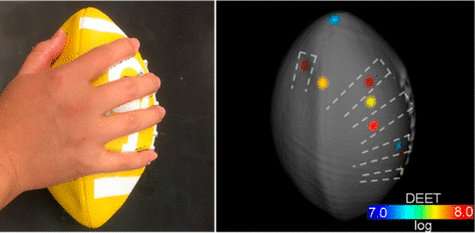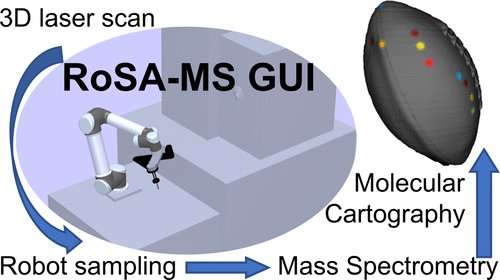Robotics takes mass spec to the third dimension for forensics, pharma applications

Within the past decade, many advancements have been made in the 3-D market from printing to movies. Now scientists report in ACS' Analytical Chemistry that by combining a robotic arm and mass spectrometry, they can analyze the surface of irregularly shaped 3-D objects, potentially opening up new branches of forensics and pharmaceutics.
Mass spectrometry (MS) is a tool that helps researchers identify the components of a sample. In recent years, the instrument has made its way outside the laboratory for use in forensics and drug screening. But current MS techniques can not examine large, bulky, curved objects without a lot of human intervention. Previously, Facundo M. Fernández and colleagues performed a proof-of concept study to show that a 3-D infrared camera could direct a robotic arm to collect samples for plasma ionization MS analysis, but only certain types of molecules could be studied with the method. In the current work, the team wanted to expand on this idea of direct surface sampling of irregularly shaped 3-D objects.
The researchers developed a new method called robotic surface analysis MS (RoSA-MS). To do this, they attached a custom-built laser scanner to a force-sensing robotic arm. The laser scanner created a digital map of the sample's surface, which directed a spring-loaded sampling probe—also attached to the arm—to certain locations. The probe briefly contacted the surfaces of objects and collected trace amounts of the material. After collecting the sample, the arm placed the probe into an electrospray ionization mass spectrometer that can analyze a wide range of samples. The researchers note that the probe could be tailored for different applications. For example, they used RoSA-MS to detect caffeine on the surface of a plastic coffee cup and to pinpoint the locations of pesticide residue on a small football.

More information: Anyin Li et al. Robotic Surface Analysis Mass Spectrometry (RoSA-MS) of Three-Dimensional Objects, Analytical Chemistry (2018). DOI: 10.1021/acs.analchem.7b04980
Abstract
Many technologies currently exist that are capable of analyzing the surface of solid samples under ambient or vacuum conditions, but they are typically limited to smooth, planar surfaces. Those few that can be applied to nonplanar surfaces, however, require manual sampling and a high degree of human intervention. Herein, we describe a new platform, Robotic Surface Analysis Mass Spectrometry (RoSA-MS), for direct surface sampling of three-dimensional (3D) objects. In RoSA-MS, a sampling probe is attached to a robotic arm that has 360° rotation through 6 individual joints. A 3D laser scanner, also attached to the robotic arm, generates a digital map of the sample surface that is used to direct a probe to specific (x, y, z) locations. The sampling probe consists of a spring-loaded needle that briefly contacts the object surface, collecting trace amounts of material. The probe is then directed at an open port liquid sampling interface coupled to the electrospray ion source of a mass spectrometer. Material on the probe tip is dissolved by the solvent flow in the liquid interface and mass analyzed with high mass resolution and accuracy. The surface of bulky, nonplanar objects can thus be probed to produce chemical maps at the molecular level. Applications demonstrated herein include the examination of food sample surfaces, lifestyle chemistry, and chemical reactions on curved substrates. The modular design of this system also allows for modifications to the sampling probe and the ionization source, thereby expanding the potential of RoSA-MS for a great diversity of applications.
Journal information: Analytical Chemistry
Provided by American Chemical Society

















